PODCAST: Establish a Winning Trial Plan
A few weeks ago, when I was at California Spring Trials, most of the breeding companies we visited mentioned availability of trial material coming soon, and I watched growers in attendance make note of this. Getting a small quantity of young plants in early to trial in your production setting is always a good idea and I’m pretty sure your suppliers appreciate any feedback you can give. But I know from first-hand experience in my days working with retail programs at Ball that far too often these trials end up “lost” or forgotten in greenhouse corners during the mad rush of spring and summer production and shipping. Sometimes, the trial material is even sold by accident.
I vividly remember walking into a greenhouse (which shall remain unnamed) and asking to see our trials. After almost an hour of searching and head scratching, the grower admitted the trials were MIA. I did get a nice lunch at the local Mexican restaurant out of it because the grower felt bad, but the chance to record trial data and see the plants in action was lost.
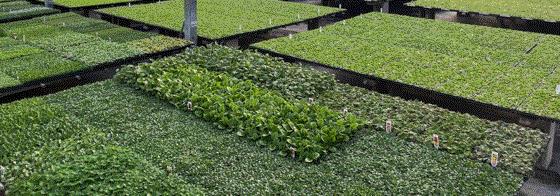
All that to say … trialing is important, and if you have a plan in place going in, your likelihood of success (and not wasting time or space) is greatly improved. That’s why I hosted a podcast on this topic with an expert who’s conducted and evaluated more than his fair share of trials. This episode was released years ago as part of my previous podcast STEM: Insider Tips for Greenhouse Pros, and I re-released it this week via Tech On Demand because it’s that good!
In CREATING YOUR TRIAL PLAN, my guest Jason Twaddell from Ball Seed digs into the why, what and when of trialing in an effort to highlight the importance of this critical piece of the growing puzzle. With margins getting narrower and the tolerance for inefficiency and shrink dropping to near zero, trialing and testing new genetics before replacing existing varieties is more important than ever.
Some of the topics he covers include trialing to solve problems and not just to evaluate what’s new; improving labor–intensive processes; and the importance of an internal champion to maximize resources. Jason details the steps to take when implementing an effective trial strategy, and how to plan and prioritize to achieve the goals you set. This episode is appropriate for many roles in your greenhouse operation, from management to section growers. Getting your team aligned when putting trials in place helps ensure the success of any greenhouse trial.
This episode AND 115+ MORE can be found on SPOTIFY, APPLE PODCASTS and just about any other podcast platform you use. Be sure to subscribe so you never miss an episode—and if you have a minute to leave a positive review, it will be greatly appreciated!

Stay Vigilant: Coleus Downy Mildew
Perhaps it’s that time of year when some fungicide applications are missed, or maybe the weather in some areas is conducive to downy mildew (DM) spread ... Either way, do NOT let your guard down, because according to my peers on the Ball Tech On Demand team, reports are already coming in from growers seeing DM on crops. Let’s start here with coleus, and then in Nick’s Tip below he’ll cover impatiens and basil.
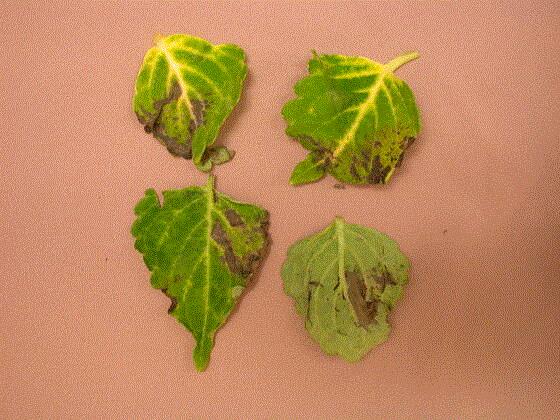 Photo: Purdue University
Photo: Purdue University
There’s a lot of university research into downy mildew, and some very clear recommendations. The first group I looked to for resources was e-GRO, and as always, they had plenty of current info available. In a COLEUS DISEASE DISORDER GUIDE, written by researchers at NC State and University of Kentucky, photos of different coleus diseases are shown alongside information and control recommendations. I highly suggest you print this out and pass it around to your production team.
Here’s an excerpt from the downy mildew section:
Initial infestations of downy mildew can be difficult to detect. Sporangia typically form on the leaf underside as a fuzzy gray growth, while the top of the leaf may not exhibit any damage. This requires continual scouting for the disease to detect early infestations. Over time the top of the leaf may develop necrotic spotting, leaf twisting, and lower leaf drop can occur.
Prior to 2000, downy mildew (Peronospora sp.) was not a major concern to North American coleus growers. After that time, widespread infestations became so severe that some growers wondered whether or not coleus would continue to be grown. Disease outbreaks have been less severe over the last 10 years and coleus are once again part of a grower’s spring crop production plan. Growing less susceptible cultivars and applying preventative fungicide sprays have aided in controlling the outbreaks of this disease.
A few more DM resources I found include a GrowerTalks article by Dr. Mary Hausbeck of Michigan State University titled DOWNY MILDEWS ARE NO FUN, as well as a coleus-specific report from MSU Extension titled WATCH OUT FOR DOWNY MILDEW ON COLEUS.
For more photos of what DM on coleus looks like, check out COLEUS—DOWNY MILDEW from UMass Extension.

Nick’s Tip of the Week: Impatiens & Basil Downy Mildew
Each week, I’ll work with my buddy Nick Flax, a technical services expert at Ball, to share a concern that’s come up during one of his numerous calls with growers across North America. This week he’s revisiting some tips shared for avoiding and dealing with downy mildew on basil and impatiens. You might recognize some of this content because I’m fairly sure he’s gone through all of this in the past—probably every year we’ve produced this newsletter. But the problem persists, so the reminders are warranted.
PROBLEM: As a group, DM-causing pathogens are difficult to detect, they strike fast, they develop resistance to fungicides very easily, and managing outbreaks can be costly for you and your customers. Downy mildews are systemic (spread throughout infected hosts) and decline and eventual death of infected plants is almost always the result. By the time symptoms and signs appear, it’s too late, so preventative management is critical. Here are a few ways you can keep out in front of downy mildew in your crops this year:
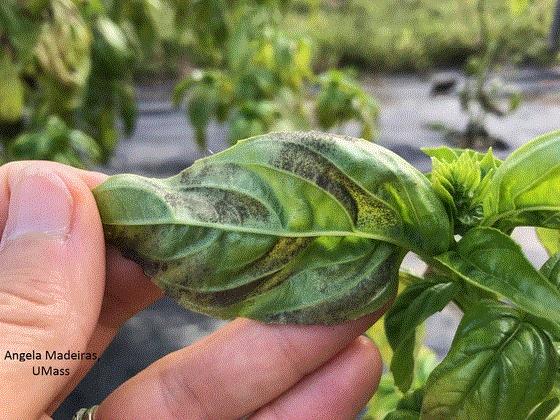
Photo: University of Massachusetts
NICK’S TIP: The best first line of defense in the battle against DM is growing resistant varieties whenever possible. Producing DM-resistant crops sets your customers up for success and reduces the risk of disease ripping through your greenhouse or garden center. The most significant DM-resistant crop on the market right now is bedding impatiens (ex. Beacon and Imara), but plant breeders are constantly working on developing resistance in other crops affected by this group of diseases. So start with resistant plants.
Beyond that, there are other best practices to follow:
Purchase seed and young plants only from trusted sources. Plasmopara obducens (the pathogen that causes IDM) is not seedborne, so this means it can only be shipped to you from one place in the supply chain: infected young plants. Note: If IDM shows up in your impatiens, it does NOT necessarily mean your supplier sent the pathogen to you. IDM infects hosts via airborne spores that can blow into your greenhouse and can survive in alternative hosts in the landscape such as jewelweed (Impatiens capensis and I. pallida). This does, however, highlight the importance of buying plugs from reliable suppliers who implement preventative DM control measures during plug production.
On the other hand, Peronospora belbahrii, which causes basil downy mildew, can be seedborne. To minimize the risk of bringing infected inputs into your greenhouse, only buy seed that has been tested for DM or plugs from young plant suppliers who only sow tested seed.
Implement preventative controls in-house. Even if you’re growing DM-resistant genetics and you’ve sourced seed and young plants from reliable suppliers, you need to continue managing DM in susceptible crops on your benches. Downy mildews generally need cool temps (upper 50s to upper 60s F) and high relative humidity to infect and develop. Minimize relative humidity in your greenhouse, avoid excessive wetting of foliage and increase airflow through the crop canopy to minimize risk of infection.
Plant pathologists have worked hard to develop strategies to manage this tricky group of pathogens in ornamentals, and one thing is very clear: good cultural practices alone are almost never enough to keep DM from striking. The best method for controlling diseases like IDM is an integration of good production practices and an aggressive fungicide program with thorough rotation of FRAC codes/MOAs.
Many products are labeled for controlling downy mildew, but not all fungicides are created equal. If you want to take a deep dive into which fungicides control different downy mildews best, check out this IR-4 report, which contains recommendations based on almost 10 years of fungicide efficacy trials. Be forewarned: This IR-4 report may be a little further “down the rabbit hole” than many of you may want to go, but there’s excellent info to be found in this document.
For those of you who are looking to scratch the surface a bit but not go down the rabbit hole, check out the following links to some very user-friendly resources our Tech On Demand team put together on managing IDM and basil DM. As always, don’t hesitate to reach out if you have any questions. Downy mildew is a tricky group of pathogens!

One Last Note on Downy Mildew …
I hope by now, most of you have switched to resistant varieties, but it’s worth a reminder that preventing impatiens downy mildew (IDM) is still necessary. Much research has been done to create fungicide rotations for those of you finishing Impatiens walleriana.
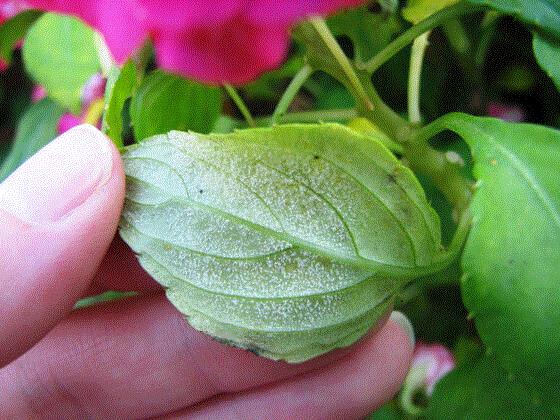
I’ll let these videos and documents speak for themselves, but it’s certainly worth taking the time to review important measures that you and your crew must take when finishing your crops.
VIDEO: Releasing Biocontrol Agents
This week, I’ve been editing articles for GrowerTalks’ upcoming 2024 Biosolutions Guide, so biocontrols of all types have been on my mind. I was happy to see a new video posted by the experts at the Vineland Research and Innovation Centre in collaboration with the Ontario Ministry of Food and Rural Affairs (OMAFRA) concisely covering proper receiving, storage and release of biocontrol agents (BCAs).
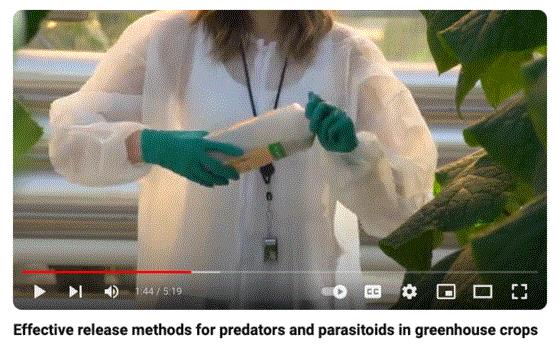
In THIS FIVE-MINUTE VIDEO, they share protocols to maximize the success of and minimize losses when applying BCAs to greenhouse crops. There’s a lot to consider, including:
-
Unpacking boxes and evaluating quality
-
Storage until use (although it’s always best to release immediately and follow the “best if used by” dates)
-
Application tools and strategies, like blowers
-
How plant spacing impacts effectiveness
-
The use of loose products versus sachets
-
How greenhouse environment and ventilation affect BCAs
-
Even distribution and releasing in “pest hot spots”
-
Correct placement of sachets
-
Banker plants

Paul Pilon on Pest Management
During this busy time of year, reading the latest issue of GrowerTalks might not be at the top of your to-do list (I know from talking with many of you, you catch up on past issues in the summer when things slow down a bit), but let me take this opportunity to call your attention to an excellent article in the April issue that’s certainly worth a read and is perfect for passing on to your team this week.
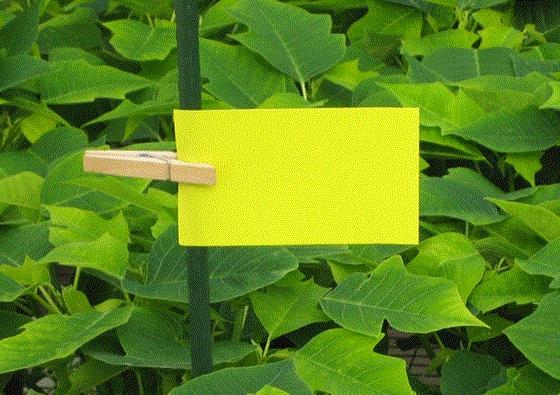
My fellow e-newsletter editor Paul Pilon of Perennial Pulse (his day job is director of growing at Opel Growers in Hudsonville, Michigan) wrote a short article titled IS SOMETHING BUGGING YOU? It's a quick read, packed with good info. He discusses the importance of scouting, of course, and how pest-free crops often start with dialed-in scouting programs, but he also includes a handy list of factors affecting the efficacy of pest management programs. Here's the rundown in case you don’t have a chance to read the full article:
Contact equals kill! Going through the motions of spraying isn’t enough. Most pesticides need to come into direct contact with the pests they’re targeting to successfully control them.
Apply the appropriate volume. Many growers use less volume than is necessary to get good coverage and obtain a high level of contact and control. There are numerous types of sprayers out there with various outputs, but with high pressure (300 psi) large-droplet spray equipment, I typically aim to apply 2 quarts of spray solution per 100 sq. ft. of area being treated.
Proper pesticides. Today’s pesticides are often very specific and only target a select group of pests. Often growers either apply the wrong products or have false expectations of what pests certain pesticides control. Read the product labels and understand which pests each pesticide controls.
Effective rates. Many growers simply apply the wrong application rates. Rates below the labeled recommendations are usually ineffective and can lead to pesticide resistance. This can also occur when applying higher-than-labeled rates, too. I tend to apply mid-labeled rates for purely preventative applications and rates towards the highest labeled recommendations when I’m trying to control moderate to high pest populations.
Frequency of application. It’s often beneficial or necessary to apply more than one application to control many greenhouse and nursery pests. Sorry—pest control is seldomly one and done.
Application interval. Purely preventative applications can be a little loosey-goosey depending on the target pests, pesticide used and personal preferences. I’ve seen preventative programs being applied monthly, biweekly and even weekly. However, curative applications will need to be applied more diligently. Again, the interval will vary by situation and pesticide use.

Finish Line ... Slugs & Snails
While wrapping up this newsletter, I got an email from one of the gentlemen on the Tech On Demand team suggesting I include some info on slugs and snails after he talked to a few growers about such pests this week.
I’ll try to dig up some more info on slug/snail prevention next week, but for now, here’s an article from longtime extension educator and professor Stanton Gill that ran in the June 2016 issue of GrowerTalks. I can’t imagine strategies to ID and control these pests have changed too much since then …
In SLUGS AND SNAILS IN GREENHOUSES, Stanton covers the topic in-depth, but here’s an excerpt to get you started:
Finding the slugs and snails may be slightly challenging. Slugs and snails prefer darkness or dim light provided by evenings—or overcast or rainy days. Slugs hang in dark, moist places protected from the desiccating sun. You’re going to have to lift flats and pots to find the slugs or snails.
After you ID the species of slug or snail you have in your greenhouse, the next step in reduction starts with sanitation. Most snails and slugs are decomposers. Feeding them leaf debris and cuttings will increase their survival. Slug populations can be reduced by eliminating their breeding and hiding places.
Unfortunately, as greenhouse operations get backed up with plants, or in the landscape where you may have created dense plantings, you have creating ideal conditions for slugs and snail populations. Slugs and snails love to hide under greenhouse flats and pots. In the landscape, they prefer dense plantings and large rocks and objects left lying in the garden.
The goal is to reduce the shelters for slugs. In the greenhouse, growing on the floor is a good way to encourage a slug and snail population. Placing plants on raised benches can help increase air circulation around the flats and pots and make conditions less conductive for slugs and snails.
Talk to you next week!



Please feel free to send your comments, constructive criticism and topic ideas to me at bcalkins@ballhort.com.

Bill Calkins
Editor - Tech On Demand
This email was received by you and 25,921 other fine subscribers!
If you're interested in advertising in Tech On Demand, contact Kim Brown ASAP and she'll hook you up.